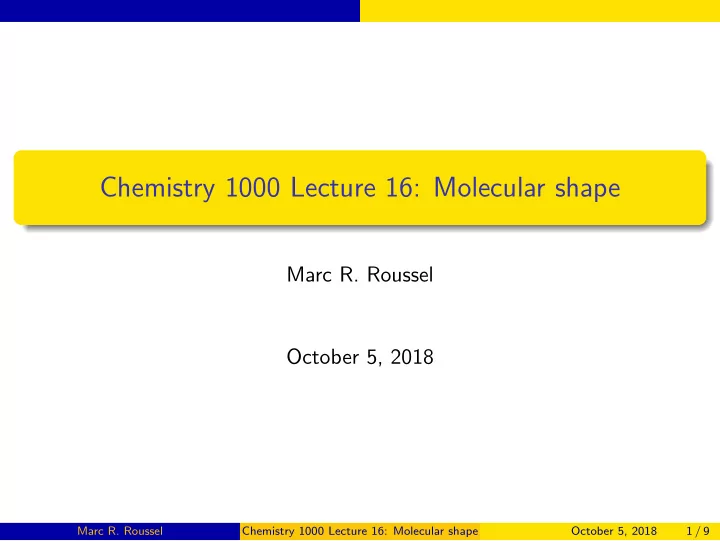

Chemistry 1000 Lecture 16: Molecular shape Marc R. Roussel October 5, 2018 Marc R. Roussel Chemistry 1000 Lecture 16: Molecular shape October 5, 2018 1 / 9
VSEPR Theory Valence Shell Electron Pair Repulsion Theory Developed in the mid-20th century by Sidgwick, Powell, Nyholm and Gillespie (McMaster University professor and U. of L. honorary degree recipient) Key ideas: Electrons repel. Valence electrons (bonding and nonbonding) are particularly close together at an end of a bond near a central atom. Electrons can be thought of as “living in groups” of nonbonding electron lone pairs and covalent bonds. A bond of any order (single, double triple) is a single group. The electronic geometry around an atom is therefore dictated by the mutual repulsion of electron groups near that atom. Electrons organize themselves so as to minimize the repulsion between groups. Marc R. Roussel Chemistry 1000 Lecture 16: Molecular shape October 5, 2018 2 / 9
VSEPR Theory Basic VSEPR Geometries Number of groups Shape Name 2 linear o 3 120 trigonal planar 109.5 o 4 tetrahedral axial position 90 o 5 trigonal bipyramidal equatorial o position 120 o 90 6 octahedral Marc R. Roussel Chemistry 1000 Lecture 16: Molecular shape October 5, 2018 3 / 9
VSEPR Theory Examples CO 2 , CH 4 , PCl 5 , SF 6 Marc R. Roussel Chemistry 1000 Lecture 16: Molecular shape October 5, 2018 4 / 9
VSEPR Theory Lone pairs Lone pairs are “fatter” than bonding pairs. Consequences: 1 Lone pairs locate themselves where there is the most space. 2 Lone pairs push the bonding electrons away, distorting their geometry away from the ideal geometry for n identical electron groups. Marc R. Roussel Chemistry 1000 Lecture 16: Molecular shape October 5, 2018 5 / 9
VSEPR Theory To name geometries of molecules with lone pairs, first determine the electronic geometry as one of the basic VSEPR geometries. Then look at the shape made by the atoms surrounding the central atom and name this shape. The names of the shapes derived from the basic VSEPR geometries will be given in the following examples: NH 3 , H 2 O, SF 4 , ClF 3 , ClF 5 , XeF 4 (Discuss bond angles in each case.) Marc R. Roussel Chemistry 1000 Lecture 16: Molecular shape October 5, 2018 6 / 9
VSEPR Theory Larger molecules We can apply VSEPR theory to each non-terminal atom. Sometimes, geometric constraints mean that we can’t obtain the “ideal” VSEPR geometry. Examples: C 2 H 4 , CH 3 CN, cyclopropane (C 3 H 6 ) Marc R. Roussel Chemistry 1000 Lecture 16: Molecular shape October 5, 2018 7 / 9
Molecular polarity Bond polarity A dipole is a pair of equal and opposite charges separated by a distance d . The strength of a dipole is measured by the dipole moment, µ = qd Polar bonds can be thought of as little dipole vectors. By convention in chemistry, these vectors point toward the negative (more electronegative) end of a bond. This is contrary to the convention in physics. Marc R. Roussel Chemistry 1000 Lecture 16: Molecular shape October 5, 2018 8 / 9
Molecular polarity Molecular polarity The overall dipole moment of a molecule is the vector sum of the bond dipoles. A molecule with a nonzero dipole moment is said to be polar. A molecule with a zero dipole moment is nonpolar. The positive and negative ends of a molecule are often labeled with the symbols δ +, δ − rather than drawing dipole moment vectors. Examples: HCl, CO 2 , O 3 , BF 3 , CH 4 , CH 3 Cl, NH 3 , SF 4 , PCl 5 , C 2 H 6 , CH 3 CHO Marc R. Roussel Chemistry 1000 Lecture 16: Molecular shape October 5, 2018 9 / 9
Recommend
More recommend